Overview
Evidence – any object, item or statement, legally submitted to competent tribunal in order to establish matter of fact under investigation. (Fisher, 2004, p. 1).
Relevant Evidence – the evidence which have any tendency to affect the probability of the existence of a fact “that is of consequence to the determination of the action.” (“FEDERAL RULES OF EVIDENCE,” 2006).
Evidences, evidence collection and the quality of evidence are directly related to the object of criminal investigation, i.e. winning convictions.
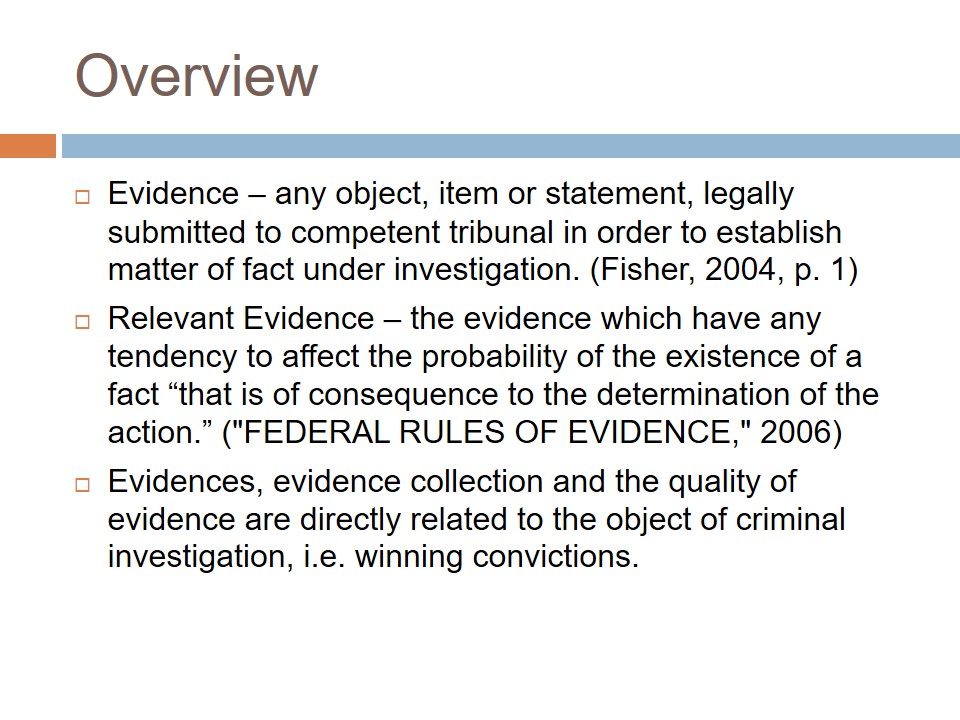
Evidence Collection
The evidences, although comprising of subgroups, can be divided into two main types:
- Physical evidences – evidence with an objective existence, i.e. has size, shape and dimension.
- The collection of evidences implies:
- General walkthrough of the crime scene;
- Recording of the crime scene, photography or video;
- Crime scene searches;
- Recording transient evidence;
- Establishing a chain of custody;
- Preserving and identifying the evidences.
- The collection of evidences implies:
- Testimonial evidences – an evidence in a form of statement made under oath and usually given as a result of questioning.
- The collection of evidences implies:
- Interview;
- Interrogation.
- The collection of evidences implies:

Examining Evidence
- Evidences are examined on the crime scene, and in case laboratory analysis is required, evidences are forwarded to servicing crime laboratory.
- Examination of physical evidences can be performed through two areas:
- Identification –determining the physical identity and the characteristics of the object.
- Comparison – establishing common origin between known and unknown specimen.
- Comparison implies looking for characteristics of the examined specimen, which can be divided into two types:
- Individual characteristics – characteristics that share a common point of origin, e.g. fingerprints.
- Class characteristics – characteristics that are shared with a group of items, e.g. blood types. (Osterburg & Ward, 1997).
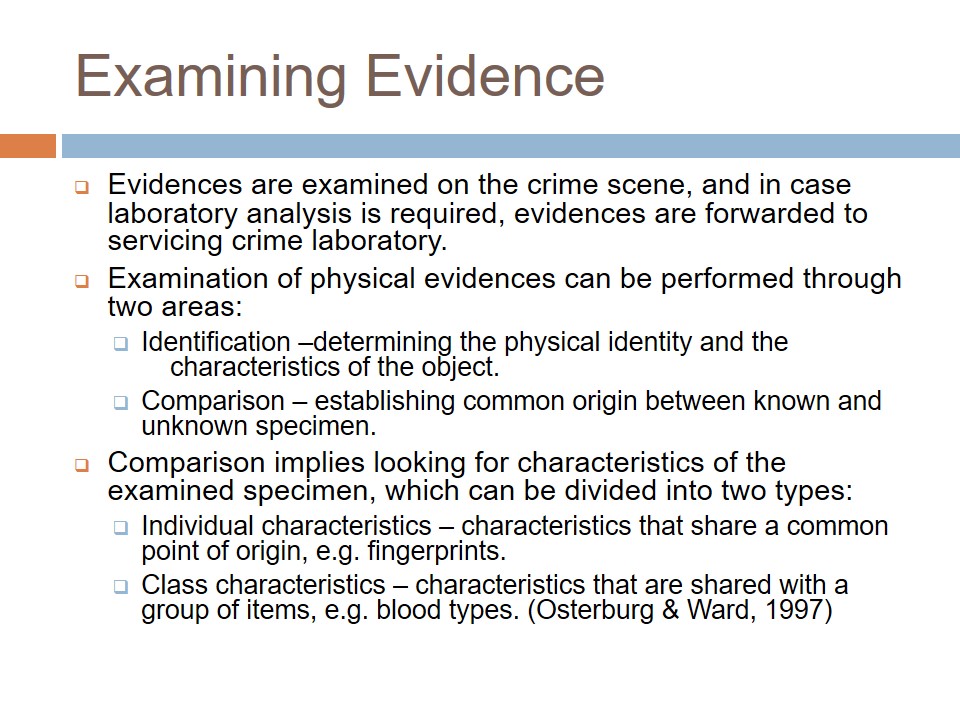
Information from Evidence
- The types of information evidences can provide depend on the type of examined evidences. Most physical evidences are needed to establish the association with a culprit if the investigation has one. The exceptions include:
- Fingerprint, as the large data base can be used for comparison.
- DNA samples, as similarly with blood data bases there are DNA banks.(American Law and Legal Information, 2009)
- Generally, the information obtained from physical evidences can provide the following information:
- The species of origin, e.g. human and animal hair.
- The relation of the specimen to the crime scene, e.g. domestic or international explosives.
- Identification of the nature of the occurring events, e.g. semen, blood, and etc.
- The relation of the suspect to the crime and the crime scene, e.g. blood, semen, and fingerprints.
- The weapon of crime, e.g. the type of firearms based on cartridge case. (Osterburg & Ward, 1997).
- Testimonial evidences can provide information based on whether the questioned person is a victim, witness, informant or suspect, and accordingly, in case of the witnesses, the division might include primary or secondary witnesses. The information might include, but not limited to the following:
- Eyewitness description and identification;
- Modus operandi;
- Motive;
- Confession;
- Psychological profiling.
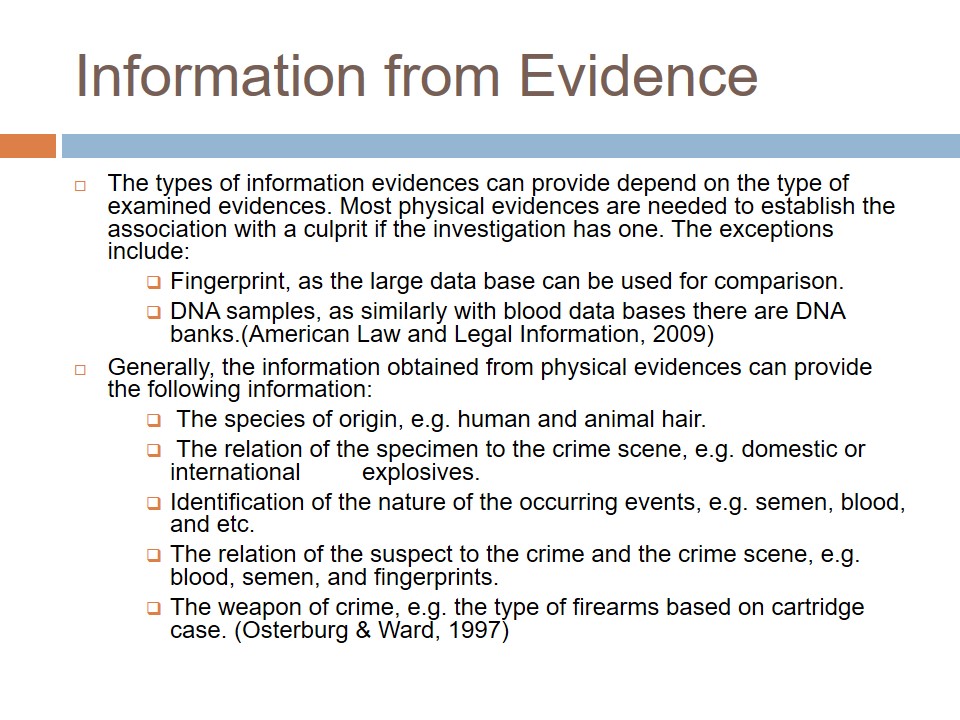
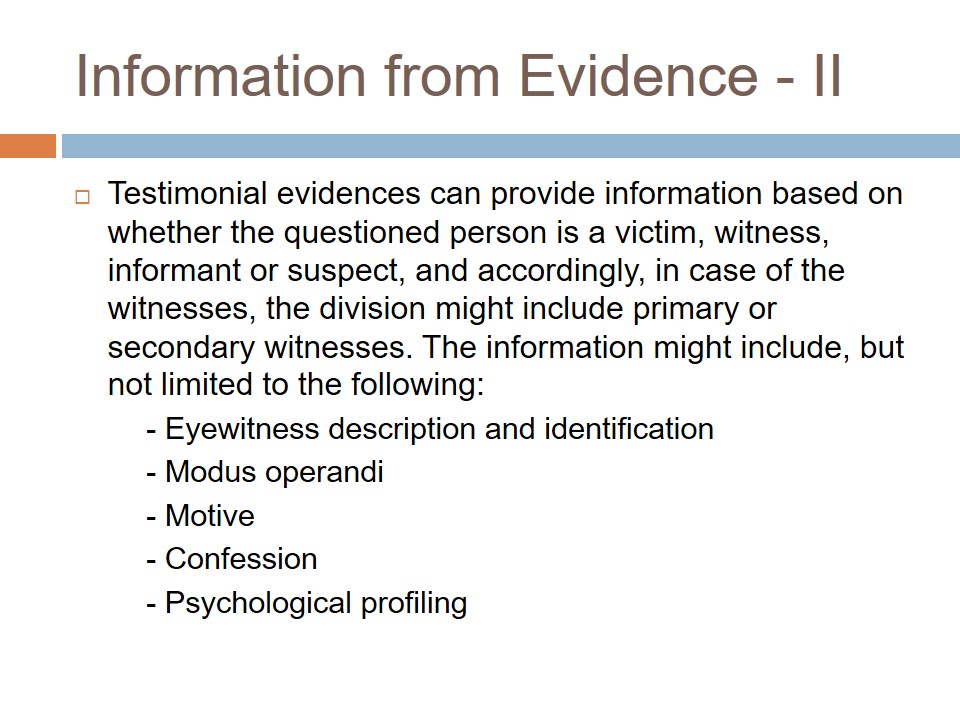
Contamination Issues
- In addition to mishandling, and destruction, evidences are subject to contamination.
- Contamination can be defined as “a concern for proper preservation of evidence.” (Fisher, 2004, p. 12).
- Issues to consider regarding contamination related to the collection of evidence might include the following:
- The contamination of the crime scene by people, animals and external elements which might alter or destruct the evidences.
- Improper packaging of evidences prior to sending them to the laboratory.
- Mixing of evidences leading to cross contamination of known and unknown specimen (Fisher, 2004, p. 157).
- Contamination of evidences present on the bodies of the victims, due to improper medical aid.
- Incorrect priorities when collecting evidences leading to the contamination or destruction of evidences. (Technical Working Group on Crime Scene Investigation, 2000).
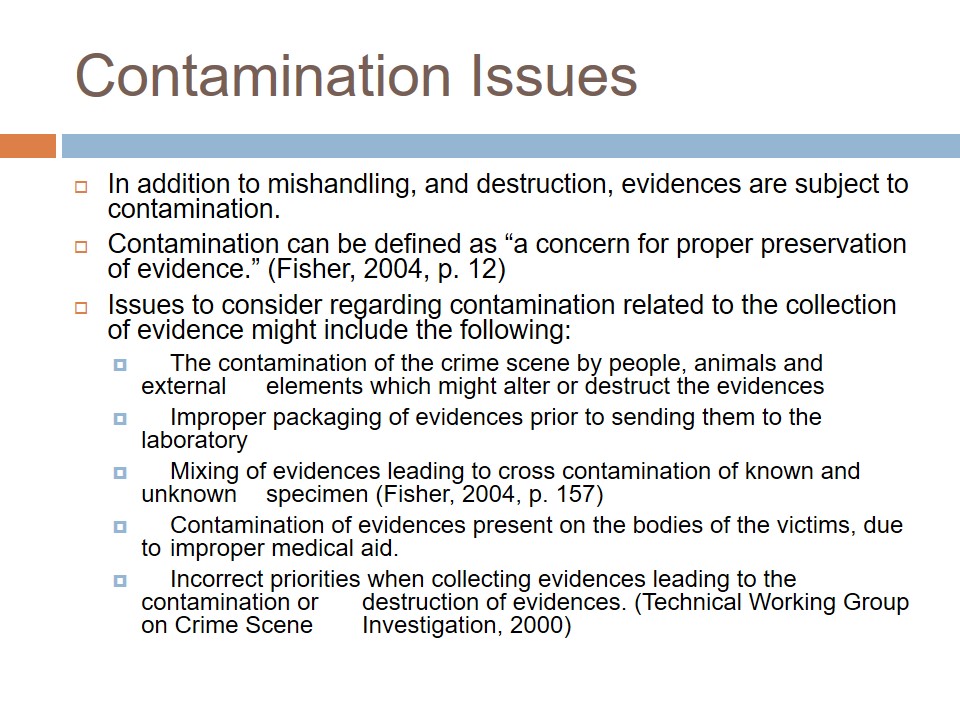
Types of Evidence
Physical evidence
- Direct physical evidence –evidence that can be touched and evaluated tactually, e.g. weapon of murder.
- Forensic physical evidence – Evidence requiring scientific validation, e.g. DNA, blood, semen and etc.
Testimonial evidence
- Direct testimonial evidence – evidence obtained from testifying witnesses, e.g. primary witness.
- Circumstantial evidence – evidence obtained from non-eyewitness testimony, e.g. secondary witness (Becker, 2008, p. 1).
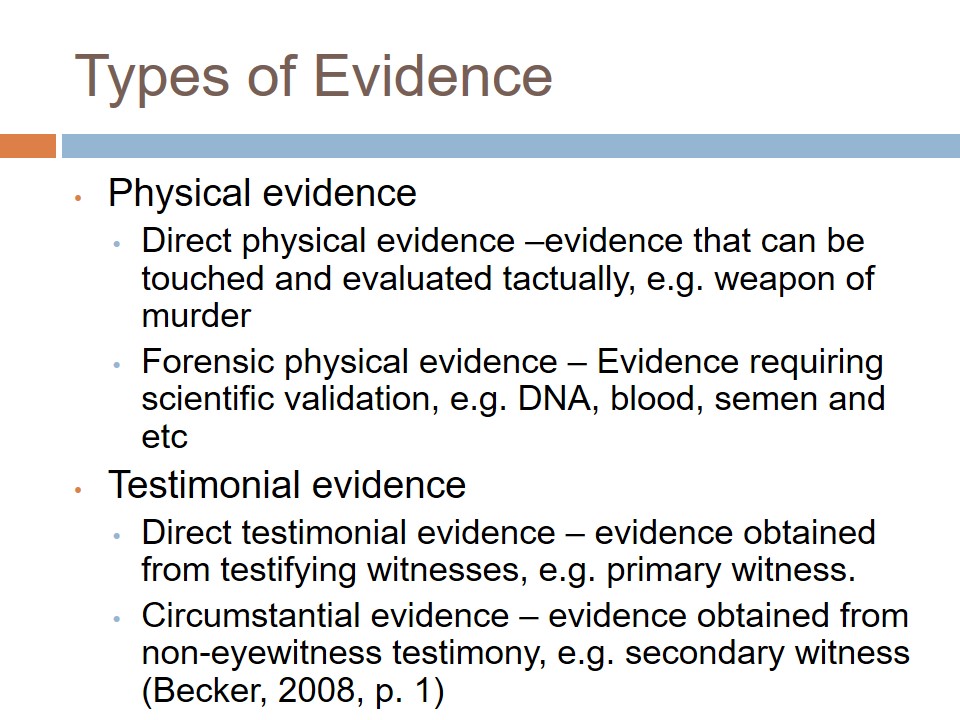
Relevant Issues
In addition to the accuracy of collecting the evidences and the efforts of preserving them an important notion should be paid to the formal procedures, which ensures the integrity of the collected evidences.
Such procedures include:
- Chain of custody – the custodians of evidence should maintain a chain of custody of all evidence collected.
- Maintaining the legality of obtaining evidences, e.g., a search warrant.
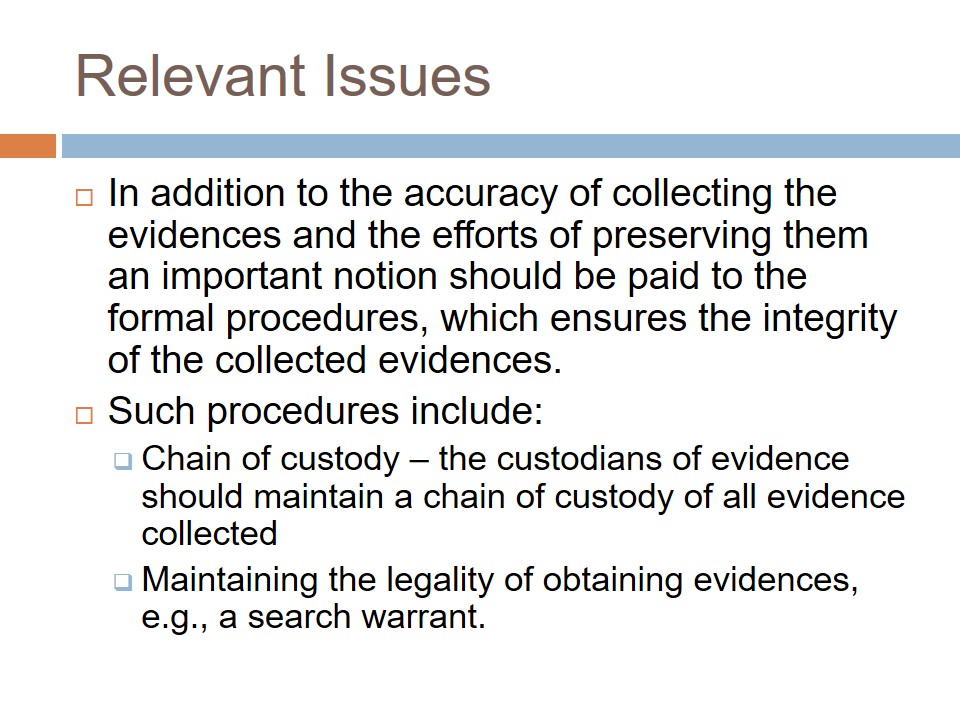
References
American Law and Legal Information. (2009). Police: Criminal Investigations – Sources Of Information And Evidence In Criminal Investigations. Net Industries. Web.
Becker, R. F. (2008). Criminal investigation (3rd ed.): Jones and Bartlett Publishers.
Federal Rules of Evidence. (2006). U.S. GOVERNMENT PRINTING OFFICE. Web.
Fisher, B. A. J. (2004). Techniques of crime scene investigation (7th ed.). Boca Raton, FL: CRC Press.
Osterburg, J. W., & Ward, R. H. (1997). Criminal investigation : a method for reconstructing the past (2nd ed.). Cincinnati, Ohio: Anderson Pub. Co.
Swanson, C. R. (2006). Criminal investigation (9th ed.). New York: McGraw-Hill.
Technical Working Group on Crime Scene Investigation. (2000). Crime Scene Investigation. U.S. Department of Justice. Web.